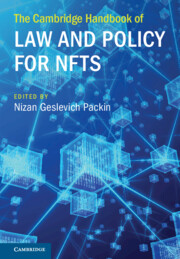Book contents
- The Cambridge Handbook of Law and Policy for NFTs
- The Cambridge Handbook of Law and Policy for NFTs
- Copyright page
- Dedication
- Contents
- Figures
- Tables
- Contributors
- Acknowledgments
- Part I Introduction and Background
- Part II Financial Regulation and Investor Protection
- Part III Capital Markets, Community, and Marketing
- Part IV Intellectual Property and Ownership Rights
- Part V Data Protection, Privacy, Cybersecurity, and NFTs
- Part VI Other Legal Issues with NFTs
- Part VII Conclusions and Future Directions
- 20 The Future of NFTs
- Index
20 - The Future of NFTs
from Part VII - Conclusions and Future Directions
Published online by Cambridge University Press: 02 November 2024
- The Cambridge Handbook of Law and Policy for NFTs
- The Cambridge Handbook of Law and Policy for NFTs
- Copyright page
- Dedication
- Contents
- Figures
- Tables
- Contributors
- Acknowledgments
- Part I Introduction and Background
- Part II Financial Regulation and Investor Protection
- Part III Capital Markets, Community, and Marketing
- Part IV Intellectual Property and Ownership Rights
- Part V Data Protection, Privacy, Cybersecurity, and NFTs
- Part VI Other Legal Issues with NFTs
- Part VII Conclusions and Future Directions
- 20 The Future of NFTs
- Index
Summary
This chapter delves into the future of the complex and evolving world of non-fungible tokens (NFTs), focusing on their potential to drive mass adoption of blockchain technology. Beginning with some historical context, the chapter explores the rapid growth of NFTs in the digital art and collectibles space, most notably during the speculative boom in 2021–2022 and the subsequent crash. The chapter then investigates how NFTs might expand beyond these initial use cases. It describes major developments in technology, business models, and financial infrastructure that will support further evolution of NFTs. Using real-world examples, the chapter then discusses emerging categories of NFT use cases, such as tokenization of physical assets, ticketing, and digital identity. It concludes by emphasizing that the true mass adoption of NFTs will occur when the technology becomes invisible and the primary draw becomes the value of use cases, not the novelty of NFTs themselves. While one should be skeptical about specific predictions for massive NFT adoption, this chapter shows that the capabilities NFTs provide are poised to add value in a wide variety of contexts.
- Type
- Chapter
- Information
- The Cambridge Handbook of Law and Policy for NFTs , pp. 397 - 416Publisher: Cambridge University PressPrint publication year: 2024

